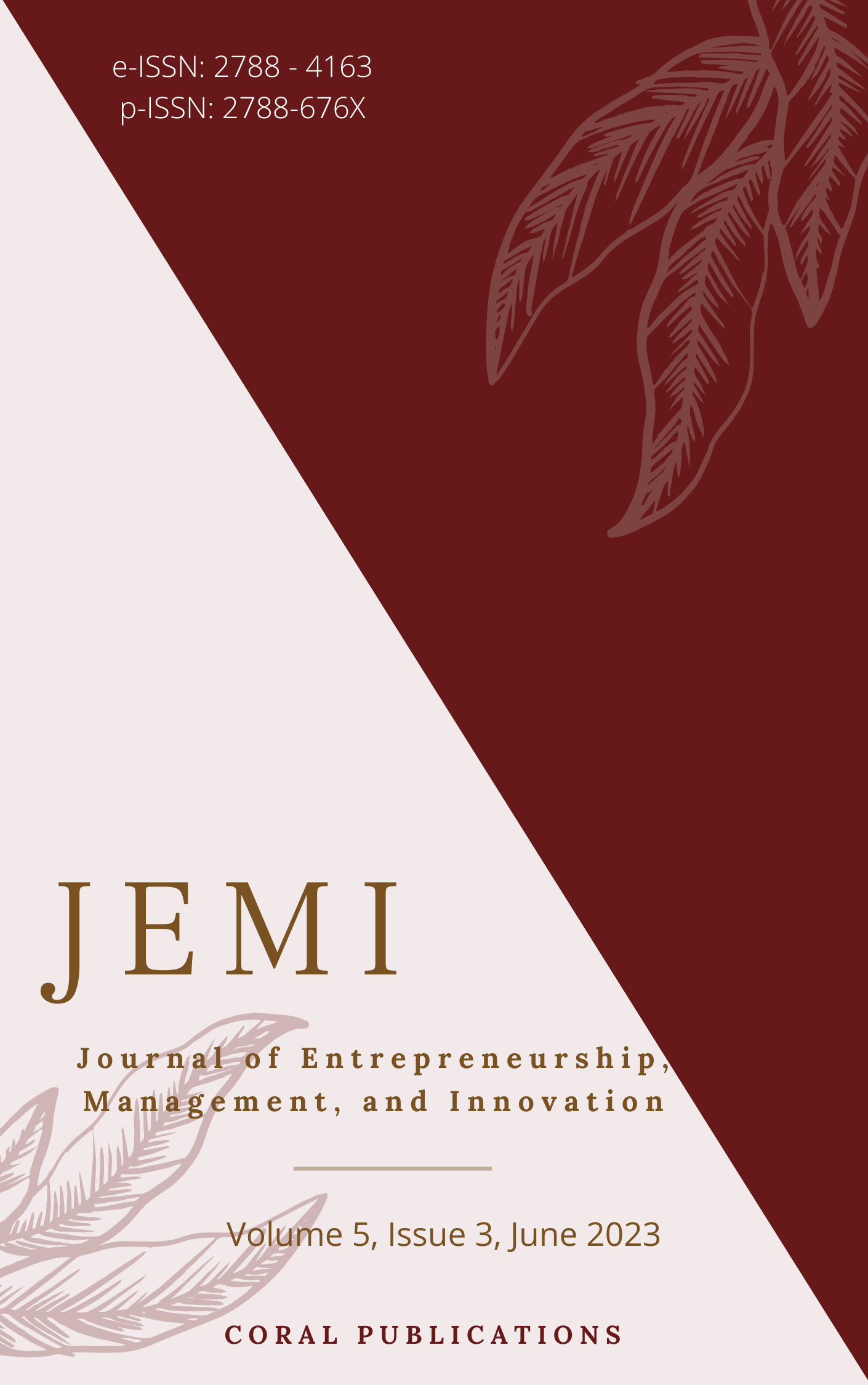The Impact of Budget Deficit, Money Supply and GDP Growth On Inflation In Pakistan: An Econometric Analysis
DOI:
https://doi.org/10.52633/jemi.v5i3.315Keywords:
Inflation, Budget deficit, Money supply, GDP Growth, Pakistan EconomyAbstract
All nations, especially developing nations, have prioritized economic growth for decades. Some governments are focusing their monetary strategy on price stability. Home inflation shows the market's pricing stability. So the current study investigates why Pakistan cannot close the deficit gap despite various measures. We'll also investigate whether Pakistan's budget deficit and money supply increase inflation. Quantitative and time series secondary data from 1980-2022 Pakistan have been used. The budget deficit (BD), money supply (MS), and GDP growth are independent variables while inflation is dependent. Two-stage least square (TSLS) testing showed that MS directly affects inflation in Pakistan. It has been found out that the growth rate of Pakistan's BD will lead to an increase in inflation; there is a correlation between the two that is both positive and statistically significant. Price stability depends on national monetary and fiscal policies. Thus, monetary expansion and inflation are often related. Money growth causes inflation, while monetary policy adjustments reflect economic trends. In addition, the OLS test used in this research concluded that BD had a direct and favorable impact on inflation. Moreover, GDP has an inverse relationship with inflation, and it is predicted that as Pakistan's GDP growth rate increases, the country's inflation rate will fall. It is recommended that Pakistan's government must prioritize productive public investment to boost economic growth and reduce inflationary pressure, tax reforms are also needed to reduce deficit financing. Pakistan should also look for ways to control its excess spending to avoid budget deficits. In the end, the government must encourage entrepreneurship and innovation to develop a business-friendly environment.
References
Anderson, T. W. (2011). The statistical analysis of time series. John Wiley & Sons.
Attia, G. M., Attia, G. M., & Emara, A. M. (2023). The causality relationship between the Budget Deficit and Inflation in Egypt. 24 (1), 72-112.
Azra, M. A., & Khan, D. (2020). Factors influencing inflation and economic growth in Pakistan: An econometric analysis. Sarhad Journal of Agriculture, 36(3), 789-797.
Bhusal, T. P. (2013). An Econometric Analysis of Deficit Budget, Money Supply, and Inflation in Nepal. Tribhuvan University Journal, 28(1-2), 315-324.
Bina, A., Rahmadana, M. F., & Yusuf, M. (2023, January). The analysis of factors affecting inflation in Indonesia. In ICoSTA 2022: Proceedings of the 4th International Conference on Science and Technology Applications, ICoSTA 2022, 1-2 November 2022, Medan, North Sumatera Province, Indonesia (p. 366). European Alliance for Innovation.
Bollen, K. A., & Paxton, P. (2017). Two-stage least squares estimation of interaction effects. In Interaction and nonlinear effects in structural equation modeling (pp. 125-152). Routledge.
Chaudhry, I. S., Ismail, R., Farooq, F., & Murtaza, G. (2015). Monetary policy and its inflationary pressure in Pakistan. Pakistan Economic and Social Review, 251-268.
Conner, B., & Johnson, E. (2017). Descriptive statistics. American Nurse Today, 12(11), 52-55.
Cottarelli, M. C. (1998). The Nonmonetary Determinants of Inflation: A Panel Data Study. International Monetary Fund.
Daniel, P. S., & Sam, A. G. (2011). Research Methodology. Gyan Publishing House.
Garba, A. M. (2023). The threshold level of budget deficit and money supply that stabilize inflation in Nigeria. Journal of Global Economics and Business, 4(13), 88-96.
Hamza, M., Bhatti, M. A., & Kiran, K. (2019). Impact of Budget Deficit on Inflation: A Case Study of Pakistan. iRASD Journal of Economics, 1(1), 42-58.
Hassan, M., Zia, M. H., & Baig, M. A. (2020). Money Supply, Fiscal Deficit, And Inflation: Evidence for Pakistan. Journal of Economics, 1(1), 51-67.
Kalumba, F. M., Mwanza, M., Chuubi, D., Mpembele, S., Kachamba, N., & Karim, A. M. (2023). The Impact of Industrial Production, Exchange Rate, and Money Supply on Inflation in Zambia: A Period Ranging from 2000 to 2020. Journal of Design, Management, and Sciences (JODMAS), 2(1), 75-88.
Kaur, P., Stoltzfus, J., & Yellapu, V. (2018). Descriptive statistics. International Journal of Academic Medicine, 4(1), 60.
Khieu, H. V. (2021). Budget deficits, money growth, and inflation: empirical evidence from Vietnam. Fulbright Review of Economics and Policy, 1(1), 61-78.
Koyuncu, A. F. T. (2014). Causality network between budget deficit, money supply, and inflation: An application to Turkey. International Journal of Business and Social Science, 5(10).
Lopez, L., & Weber, S. (2017). Testing for Granger causality in panel data. The Stata Journal, 17(4), 972-984.
Manullang, A. L., Hutasoit, D. H., Matondang, K. A., & Indiriani, R. (2023). Monetary Policy Effectiveness on Inflation and Growth Economy in Century Covid-19 Pandemic. International Journal of Business and Applied Economics, 2(1), 51-58.
Narayan, P. K., Narayan, S., & Prasad, A. D. (2019). Modelling the relationship between budget deficits, money supply, and inflation in Fiji.
Nassar, K. (2005). Money demand and inflation in Madagascar.
Nguyen, B. (2015). Effects of fiscal deficit and money M2 supply on inflation: Evidence from selected economies of Asia. Journal of Economics, Finance and Administrative Science, 20, 49-53.
Pandey, P., & Pandey, M. M. (2021). Research Methodology Tools and Techniques. Bridge Center.
Priya, S. S., Cuce, E., & Sudhakar, K. (2021). A perspective of Covid 19 impact on the global economy, energy, and environment. International Journal of Sustainable Engineering, 14(6), 1290-1305.
Şahin, B. E. (2019). Analysis of the relationship between inflation, budget deficit, and money supply in Turkey by ARDL approach: 1980-2017. Journal of Life Economics, 6(3), 297-306.
Shukur, G., & Mantalos, P. (2004). Size and power of the RESET test as applied to systems of equations: A bootstrap approach. Journal of Modern Applied Statistical Methods, 3(2), 10.
Downloads
Published
Issue
Section
License
Copyright (c) 2023 Maria Batool, Nimra Naveed Shaikh and Waqas Bin Dilshad (Authors)

This work is licensed under a Creative Commons Attribution 4.0 International License.











